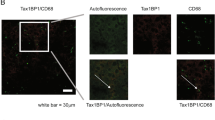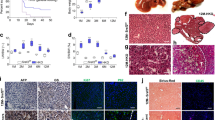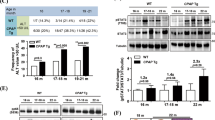Abstract
Transcription factors with helix–loop–helix (HLH) motif play critical roles in controlling the expression of genes involved in lineage commitment, cell fate determination, proliferation, and tumorigenesis. To examine whether the newly identified HLH protein GCIP/CCNDBP1 modulates cell fate determination and plays a role in hepatocyte growth, proliferation, and hepatocarcinogenesis, we generated transgenic mice with human GCIP gene driven by a liver-specific albumin promoter. We demonstrated that in GCIP transgenic mice, the overall liver growth and regeneration occurred normally after liver injury induced by carbon tetrachloride (CCl4). In the diethylnitrosamine (DEN)-induced mouse hepatocarcinogenesis, we demonstrated that overexpression of GCIP in mouse liver suppressed DEN-induced hepatocarcinogenesis at an early stage of tumor development. The number of hepatic adenomas at 24 weeks was significantly lower or not detected in GCIP transgenic male mice compared to the control mice under the same treatment. Although GCIP has little inhibition on the number of hepatic tumors at later stages (40 weeks), hepatocellular tumors in GCIP transgenic mice are smaller and well-differentiated compared to the poorly differentiated tumors in wild-type mice. Furthermore, we demonstrate that GCIP functions as a transcriptional suppressor, regulates the expression of cyclin D1, and inhibits anchorage-independent cell growth and colony formation in HepG2 cells, suggesting a significant role of GCIP in tumor initiation and development.
This is a preview of subscription content, access via your institution
Access options
Subscribe to this journal
Receive 50 print issues and online access
$259.00 per year
only $5.18 per issue
Buy this article
- Purchase on Springer Link
- Instant access to full article PDF
Prices may be subject to local taxes which are calculated during checkout





Similar content being viewed by others
References
Barndt RJ, Dai M, Zhuang Y . (2000). Mol Cell Biol 20: 6677–6685.
Benezra R, Davis RL, Lockshon D, Turner DL, Weintraub H . (1990). Cell 61: 49–59.
Blackwell TK, Kretzner L, Blackwood EM, Eisenman RN, Weintraub H . (1990). Science 250: 1149–1151.
Conner EA, Lemmer ER, Omori M, Wirth PJ, Factor VM, Thorgeirsson SS . (2000). Oncogene 19: 5054–5062.
Cooper TA . (2005). Cell 120: 1–2.
Cordle SR, Henderson E, Masuoka H, Weil PA, Stein R . (1991). Mol Cell Biol 11: 1734–1738.
Deane NG, Lee H, Hamaamen J, Ruley A, Washington MK, LaFleur B et al. (2004). Cancer Res 64: 1315–1322.
Deane NG, Parker MA, Aramandla R, Diehl L, Lee WJ, Washington MK et al. (2001). Cancer Res 61: 5389–5395.
Diwan BA, Meier H . (1976). Cancer Lett 1: 249–253.
Gaubatz S, Meichle A, Eilers M . (1994). Mol Cell Biol 14: 3853–3862.
Hollenberg SM, Sternglanz R, Cheng PF, Weintraub H . (1995). Mol Cell Biol 15: 3813–3822.
Hu JS, Olson EN, Kingston RE . (1992). Mol Cell Biol 12: 1031–1042.
Hwang SY, Oh B, Fuchtbauer A, Fuchtbauer EM, Johnson KR, Solter D et al. (1997). Dev Dyn 209: 217–226.
Jemal A, Murray T, Ward E, Samuels A, Tiwari RC, Ghafoor A et al. (2005). CA Cancer J Clin 55: 10–30.
Jensen J, Pedersen EE, Galante P, Hald J, Heller RS, Ishibashi M et al. (2000). Nat Genet 24: 36–44.
Kee BL, Quong MW, Murre C . (2000). Immunol Rev 175: 138–149.
Kenny FS, Hui R, Musgrove EA, Gee JM, Blamey RW, Nicholson RI et al. (1999). Clin Cancer Res 5: 2069–2076.
Knight B, Yeoh GC, Husk KL, Ly T, Abraham LJ, Yu C et al. (2000). J Exp Med 192: 1809–1818.
Kreider BL, Benezra R, Rovera G, Kadesch T . (1992). Science 255: 1700–1702.
Lassar AB, Davis RL, Wright WE, Kadesch T, Murre C, Voronova A et al. (1991). Cell 66: 305–315.
Ledda-Columbano GM, Pibiri M, Concas D, Cossu C, Tripodi M, Columbano A . (2002). Hepatology 36: 1098–1105.
Lee C, Wang Q . (2005). Brief Bioinform 6: 23–33.
Lee GH, Ooasa T, Osanai M . (1998). Cancer Res 58: 1665–1669.
Lee JE, Hollenberg SM, Snider L, Turner DL, Lipnick N, Weintraub H . (1995). Science 268: 836–844.
Lemmer ER, Vessey CJ, Gelderblom WC, Shephard EG, Van Schalkwyk DJ, Van Wijk RA et al. (2004). Carcinogenesis 25: 1257–1264.
Lyden D, Young AZ, Zagzag D, Yan W, Gerald W, O'Reilly R et al. (1999). Nature 401: 670–677.
Ma Q, Kintner C, Anderson DJ . (1996). Cell 87: 43–52.
Massari ME, Murre C . (2000). Mol Cell Biol 20: 429–440.
Molkentin JD, Black BL, Martin JF, Olson EN . (1995). Cell 83: 1125–1136.
Moore MR, Drinkwater NR, Miller EC, Miller JA, Pitot HC . (1981). Cancer Res 41: 1585–1593.
Motokura T, Arnold A . (1993). Genes Chromosomes Cancer 7: 89–95.
Murre C, McCaw PS, Vaessin H, Caudy M, Jan LY, Jan YN et al. (1989). Cell 58: 537–544.
Nabeshima Y, Hanaoka K, Hayasaka M, Esumi E, Li S, Nonaka I . (1993). Nature 364: 532–535.
Nakatani T, Roy G, Fujimoto N, Asahara T, Ito A . (2001). Jpn J Cancer Res 92: 249–256.
Natrajan R, Louhelainen J, Williams S, Laye J, Knowles MA . (2003). Cancer Res 63: 7657–7662.
Nishida N, Fukuda Y, Ishizaki K, Nakao K . (1997). Histol Histopathol 12: 1019–1025.
Nishida N, Fukuda Y, Komeda T, Kita R, Sando T, Furukawa M et al. (1994). Cancer Res 54: 3107–3110.
Peppelenbosch MP, Qiu RG, de Vries-Smits AM, Tertoolen LG, de Laat SW, McCormick F et al. (1995). Cell 81: 849–856.
Perk J, Iavarone A, Benezra R . (2005). Nat Rev Cancer 5: 603–614.
Pestell RG, Albanese C, Reutens AT, Segall JE, Lee RJ, Arnold A . (1999). Endocr Rev 20: 501–534.
Pin CL, Rukstalis JM, Johnson C, Konieczny SF . (2001). J Cell Biol 155: 519–530.
Recknagel RO, Glende Jr EA, Dolak JA, Waller RL . (1989). Pharmacol Ther 43: 139–154.
Rivera R, Murre C . (2001). Oncogene 20: 8308–8316.
Rivera RR, Johns CP, Quan J, Johnson RS, Murre C . (2000). Immunity 12: 17–26.
Roskams TA, Libbrecht L, Desmet VJ . (2003). Semin Liver Dis 23: 385–396.
Ruzinova MB, Benezra R . (2003). Trends Cell Biol 13: 410–418.
Shirakata M, Paterson BM . (1995). EMBO J 14: 1766–1772.
Sierralta J, Mendoza C . (2004). Brain Res Brain Res Rev 47: 105–115.
Sikder H, Huso DL, Zhang H, Wang B, Ryu B, Hwang ST et al. (2003). Cancer Cell 4: 291–299.
Spicer DB, Rhee J, Cheung WL, Lassar AB . (1996). Science 272: 1476–1480.
Stamm S, Ben-Ari S, Rafalska I, Tang Y, Zhang Z, Toiber D et al. (2005). Gene 344: 1–20.
Sugihara S, Nakashima O, Kojiro M, Majima Y, Tanaka M, Tanikawa K . (1992). Cancer 70: 1488–1492.
Sun XH, Copeland NG, Jenkins NA, Baltimore D . (1991). Mol Cell Biol 11: 5603–5611.
Sun Y, Nadal-Vicens M, Misono S, Lin MZ, Zubiaga A, Hua X et al. (2001). Cell 104: 365–376.
Suzui M, Masuda M, Lim JT, Albanese C, Pestell RG, Weinstein IB . (2002). Cancer Res 62: 3997–4006.
Takami T, Terai S, Yokoyama Y, Tanimoto H, Tajima K, Uchida K et al. (2005). Gastroenterology 128: 1369–1380.
Terai S, Aoki H, Ashida K, Thorgeirsson SS . (2000). Hepatology 32: 357–366.
Theise ND, Yao JL, Harada K, Hytiroglou P, Portmann B, Thung SN et al. (2003). Histopathology 43: 263–271.
Venables JP . (2004). Cancer Res 64: 7647–7654.
Vesselinovitch SD . (1987). Toxicol Pathol 15: 221–228.
Voronova AF, Lee F . (1994). Proc Natl Acad Sci USA 91: 5952–5956.
Wroblewski F . (1959). Am J Med 27: 911–923.
Xia C, Bao Z, Tabassam F, Ma W, Qiu M, Hua S et al. (2000). J Biol Chem 275: 20942–20948.
Yao Y, Doki Y, Jiang W, Imoto M, Venkatraj VS, Warburton D et al. (2000). Exp Cell Res 257: 22–32.
Yokota Y, Mori S . (2002). J Cell Physiol 190: 21–28.
Zebedee Z, Hara E . (2001). Oncogene 20: 8317–8325.
Zhao XF, Aplan PD . (1999). J Biol Chem 274: 1388–1393.
Zhuang Y, Kim CG, Bartelmez S, Cheng P, Groudine M, Weintraub H . (1992). Proc Natl Acad Sci USA 89: 12132–12136.
Acknowledgements
This work was supported partially from NIH Grants (5R01HL064792 and 1R01CA106479). We would like to thank members of the Liu laboratory and members of the Center for Cancer Biology and Nutrition for their comments and discussion.
Author information
Authors and Affiliations
Corresponding author
Rights and permissions
About this article
Cite this article
Ma, W., Xia, X., Stafford, L. et al. Expression of GCIP in transgenic mice decreases susceptibility to chemical hepatocarcinogenesis. Oncogene 25, 4207–4216 (2006). https://doi.org/10.1038/sj.onc.1209450
Received:
Revised:
Accepted:
Published:
Issue Date:
DOI: https://doi.org/10.1038/sj.onc.1209450
Keywords
This article is cited by
-
Structure of a dominant-negative helix-loop-helix transcriptional regulator suggests mechanisms of autoinhibition
The EMBO Journal (2012)
-
Accelerated hepatocellular carcinoma development in mice expressing the Pim-3 transgene selectively in the liver
Oncogene (2010)
-
A novel mouse model of hepatocarcinogenesis triggered by AID causing deleterious p53 mutations
Oncogene (2009)
-
Ribosomal phosphoprotein P0 interacts with GCIP and overexpression of P0 is associated with cellular proliferation in breast and liver carcinoma cells
Oncogene (2008)
-
An Id-like molecule, HHM, is a synexpression group-restricted regulator of TGF-β signalling
The EMBO Journal (2008)



